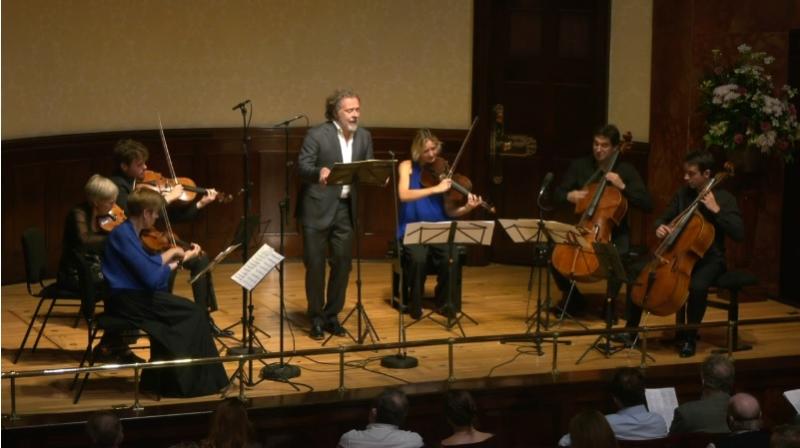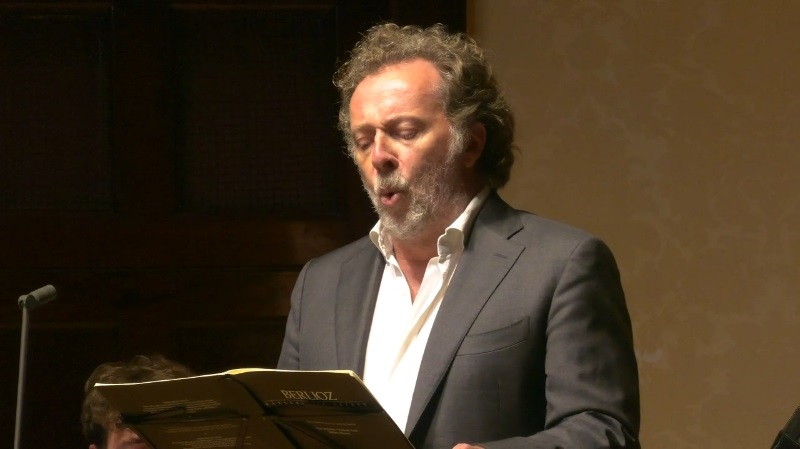Gerhaher, Faust, Wigmore Hall review - husky shadings and dark hues | reviews, news & interviews
Gerhaher, Faust, Wigmore Hall review - husky shadings and dark hues
Gerhaher, Faust, Wigmore Hall review - husky shadings and dark hues
Night themed recital presents new Berlioz arrangement, plus rarely heard Schoeck

Christian Gerhaher and a string ensemble led by Isabelle Faust presented here a programme of works with a nocturnal theme. Gerhaher’s voice is an instrument of husky shadings and dark hues, so the night theme seemed wholly appropriate.
Schoeck composed the cycle, for baritone and string quartet, in 1931-3. The composer himself was Swiss, but had studied in Germany with Max Reger. His music is rooted in German Romanticism, with considerable harmonic and contrapuntal complexity – the strings do far more than accompany here – but there is also a feeling of restraint, as if everything is happening on a predetermined scale of expression. All of which suits Gerhaher very well. He is a versatile singer, capable of Wagner, but more at home on the recital stage. His sound is utterly distinctive, but hard to describe. Even when singing with broad tone, he has a nasal quality, but its hardly constrictive.
Just as often, he brings the sound down to a conspiratorial parlando, often craning over the stand towards the audience, as if whispering a confession. After hearing Gerhaher sing Schoeck, it is hard to imagine it being done any other way. The scoring, though, suggests a bigger voice, and the strings often matched Gerhaher in volume, though rarely smothered him. Technically, you could fault him on a number of counts. Those speech-like passages are often accompanied by a flattening of pitch, which stood out when he sang in unison with the sustaining strings. He also drops away from long notes, especially at the ends of phrases. But the work is about more than the singer. The second movement (of five), and a large section of the first, don’t involve the singer at all. In these passages, we hear complex counterpoint, but also startling portamento effects and complex, unpredictable chord sequences. Notturno is a great vehicle for Gerhaher, but it is also much more than that.  It’s not often that the lollipop on a concert programme is the Schoenberg, but the most popular work here was his Verklärte Nacht. In the Schock, the cellist was Jean-Guihen Queyras, and when the group was expanded to sextet for the Schoenberg and Berlioz, the additional cellist was Christian Poltéra – luxury casting! Verklärte Nacht really benefited from this top-class cello pairing. It is a bottom heavy score, and the tone and texture are determined by the cellos. Both brought rich, dark colouring, but always controlled and with excellent articulation and phrasing. That set the tone for a powerful and richly hued reading. The quietest passages, including the beginning and end, were played at a whisper, and the louder passages shone with clear, focussed intensity. Surprisingly, Isabelle Faust didn’t match the clarity or precision of her ensemble. Her intonation at the top was shaky, and her tone on the G-string was dry.
It’s not often that the lollipop on a concert programme is the Schoenberg, but the most popular work here was his Verklärte Nacht. In the Schock, the cellist was Jean-Guihen Queyras, and when the group was expanded to sextet for the Schoenberg and Berlioz, the additional cellist was Christian Poltéra – luxury casting! Verklärte Nacht really benefited from this top-class cello pairing. It is a bottom heavy score, and the tone and texture are determined by the cellos. Both brought rich, dark colouring, but always controlled and with excellent articulation and phrasing. That set the tone for a powerful and richly hued reading. The quietest passages, including the beginning and end, were played at a whisper, and the louder passages shone with clear, focussed intensity. Surprisingly, Isabelle Faust didn’t match the clarity or precision of her ensemble. Her intonation at the top was shaky, and her tone on the G-string was dry.
Berlioz’s music thrives on instrumental colour, so reducing his orchestration is asking for trouble. In fact, Les nuits d’éte started out as a cycle for voice and piano, which Berlioz then orchestrated, so David Matthews’s new arrangement for string sextet sits somewhere in between. Gerhaher gave another reading that began with the words, sung in impressively idiomatic French, with the musical line a colouring to his shapely phrases. Again, phrases often drifted under the pitch towards the end, and sustained climaxes seemed to be deliberately curtailed. This time, the more modest scoring laid those traits out bare. In Matthews’s hands, the instrumental textures remain very much accompaniment. He distributes the music subtly, for example bring the sextet down to a string quartet for extended passages, but then adding in the two extra instruments as pizzicato lines. Most of these songs are dark and sombre, which again suits Gerhaher’s gaunt tone. But Berlioz ends on a high note. His last song, “L'île inconnue,” is broad and radiant. Matthews voices the textures broadly, and Gerhaher follows suit, finally putting the full weight of his tone behind the lines. A bright end to a distinctly gloomy evening.
rating
Explore topics
Share this article
The future of Arts Journalism
You can stop theartsdesk.com closing!
We urgently need financing to survive. Our fundraising drive has thus far raised £49,000 but we need to reach £100,000 or we will be forced to close. Please contribute here: https://gofund.me/c3f6033d
And if you can forward this information to anyone who might assist, we’d be grateful.

Subscribe to theartsdesk.com
Thank you for continuing to read our work on theartsdesk.com. For unlimited access to every article in its entirety, including our archive of more than 15,000 pieces, we're asking for £5 per month or £40 per year. We feel it's a very good deal, and hope you do too.
To take a subscription now simply click here.
And if you're looking for that extra gift for a friend or family member, why not treat them to a theartsdesk.com gift subscription?
more Classical music
 Bizet in 150th anniversary year: rich and rare French offerings from Palazzetto Bru Zane
Specialists in French romantic music unveil a treasure trove both live and on disc
Bizet in 150th anniversary year: rich and rare French offerings from Palazzetto Bru Zane
Specialists in French romantic music unveil a treasure trove both live and on disc
 Scottish Chamber Orchestra, Ibragimova, Queen’s Hall, Edinburgh review - rarities, novelties and drumrolls
A pity the SCO didn't pick a better showcase for a shining guest artist
Scottish Chamber Orchestra, Ibragimova, Queen’s Hall, Edinburgh review - rarities, novelties and drumrolls
A pity the SCO didn't pick a better showcase for a shining guest artist
 Kilsby, Parkes, Sinfonia of London, Wilson, Barbican review - string things zing and sing in expert hands
British masterpieces for strings plus other-worldly tenor and horn - and a muscular rarity
Kilsby, Parkes, Sinfonia of London, Wilson, Barbican review - string things zing and sing in expert hands
British masterpieces for strings plus other-worldly tenor and horn - and a muscular rarity
 From Historical to Hip-Hop, Classically Black Music Festival, Kings Place review - a cluster of impressive stars for the future
From quasi-Mozartian elegance to the gritty humour of a kitchen inspection
From Historical to Hip-Hop, Classically Black Music Festival, Kings Place review - a cluster of impressive stars for the future
From quasi-Mozartian elegance to the gritty humour of a kitchen inspection
 Shibe, LSO, Adès, Barbican review - gaudy and glorious new music alongside serene Sibelius
Adès’s passion makes persuasive case for the music he loves, both new and old
Shibe, LSO, Adès, Barbican review - gaudy and glorious new music alongside serene Sibelius
Adès’s passion makes persuasive case for the music he loves, both new and old
 Anja Mittermüller, Richard Fu, Wigmore Hall review - a glorious hall debut
The Austrian mezzo shines - at the age of 22
Anja Mittermüller, Richard Fu, Wigmore Hall review - a glorious hall debut
The Austrian mezzo shines - at the age of 22
 First Person: clarinettist Oliver Pashley on the new horizons of The Hermes Experiment's latest album
Compositions by members of this unusual quartet feature for the first time
First Person: clarinettist Oliver Pashley on the new horizons of The Hermes Experiment's latest album
Compositions by members of this unusual quartet feature for the first time
 Gesualdo Passione, Les Arts Florissants, Amala Dior Company, Barbican review - inspired collaboration excavates the music's humanity
At times it was like watching an anarchic religious procession
Gesualdo Passione, Les Arts Florissants, Amala Dior Company, Barbican review - inspired collaboration excavates the music's humanity
At times it was like watching an anarchic religious procession
 Classical CDs: Camels, concrete and cabaret
An influential American composer's 90th birthday box, plus British piano concertos and a father-and-son duo
Classical CDs: Camels, concrete and cabaret
An influential American composer's 90th birthday box, plus British piano concertos and a father-and-son duo
 Cockerham, Manchester Camerata, Sheen, Martin Harris Centre, Manchester review - re-enacting the dawn of modernism
Two UK premieres added to three miniatures from a seminal event of January 1914
Cockerham, Manchester Camerata, Sheen, Martin Harris Centre, Manchester review - re-enacting the dawn of modernism
Two UK premieres added to three miniatures from a seminal event of January 1914
 Kempf, Brno Philharmonic, Davies, Bridgewater Hall, Manchester review - European tradition meets American jazz
Bouncing Czechs enjoy their Gershwin and Brubeck alongside Janáček and Dvořák
Kempf, Brno Philharmonic, Davies, Bridgewater Hall, Manchester review - European tradition meets American jazz
Bouncing Czechs enjoy their Gershwin and Brubeck alongside Janáček and Dvořák
 Solomon, OAE, Butt, QEH review - daft Biblical whitewashing with great choruses
Even a top soprano and mezzo can’t make this Handel paean wholly convincing
Solomon, OAE, Butt, QEH review - daft Biblical whitewashing with great choruses
Even a top soprano and mezzo can’t make this Handel paean wholly convincing

Add comment